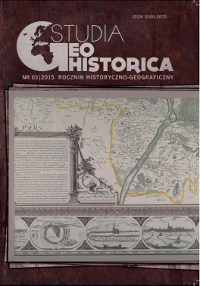Program terytorialny Komitetu Narodowego Polskiego i delegacji polskiej na konferencji pokojowej w Wersalu
The Territorial Program of the Polish National Committee and the Polish Government Delegation at the Peace Conference in Versailles
Author(s): Piotr EberhardtSubject(s): Human Geography, Historical Geography
Published by: Polskie Towarzystwo Historyczne
Keywords: granice Polski;traktat wersalski;borders of Poland;Treaty of Versailles;Roman Dmowski
Summary/Abstract: The article presents the territorial program of Poland prepared in the years 1917/1919 by the Polish National Committee. Th e latter was a political organization initially working in Lausanne and later in Paris. Its unquestionable leader and ideologist was Roman Dmowski. After the Polish National Committee initiated its activity, it prepared a project of the postulated future borders of the Polish state (map No. 1). It contained the Kingdom of Poland, Wielkopolska (Greater Poland), Gdańsk Pomerania, East Prussia, ethnical Lithuania with Vilnius, Austrian Galicia, Polesia, Grodno governorate and a small part of western Volhynia. Th e eastern border was marked along the German-Russian front in August 1917. Th e program of the border was in those political conditions unrealistic; however, it provided the basis to prepare an official standpoint of the Polish government delegation at the Peace Conference in Paris. In the meantime, the political relations underwent changes, which was caused by the defeat of the Central Powers and the revolution in Russia. Th e author of the territorial program of Poland was Dmowski himself and he presented it during the sessions of the victorious western powers in Vienna. The principal element of the program was a map which showed a cartographic presentation of Poland’s territorial claims (map No. 2). The Polish standpoint was an object of controversy between the great powers. The Polish desiderata were supported by France and opposed by Great Britain. This was presented and commented upon. The final effect was the creation of an independent Polish state whose western borders were determined in the Treaty of Versailles. The later Polish-Bolshevik war finished with the Treaty of Riga (1921), which established the eastern borders of Poland. The further part of the present article provides a comparative analysis of the Polish postulates and the later actual political borders (map No. 3). Not all Polish postulates were fulfilled. Nevertheless, a sovereign Polish state was created with access to the sea, while the borders of the invaders (Germany, Russia and Austro-Hungary), which tore the Polish territories apart and which were established during the Congress of Vienna (1815), disappeared.
Journal: Studia Geohistorica
- Issue Year: 2015
- Issue No: 3
- Page Range: 127-140
- Page Count: 14
- Language: Polish

